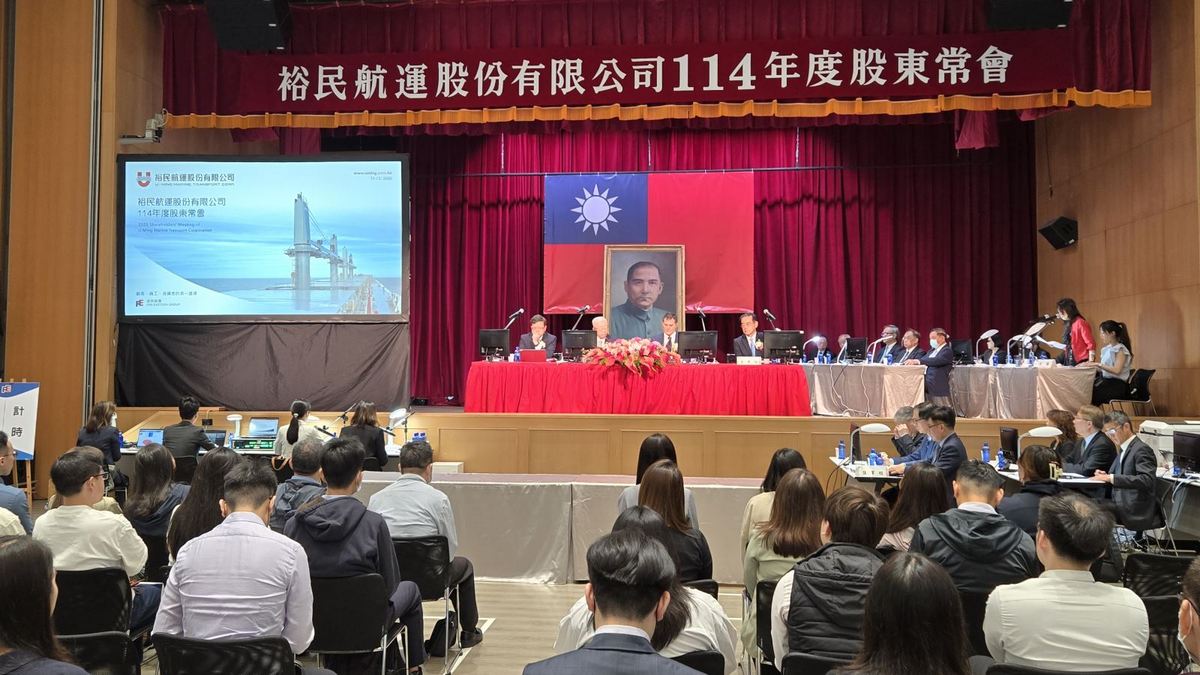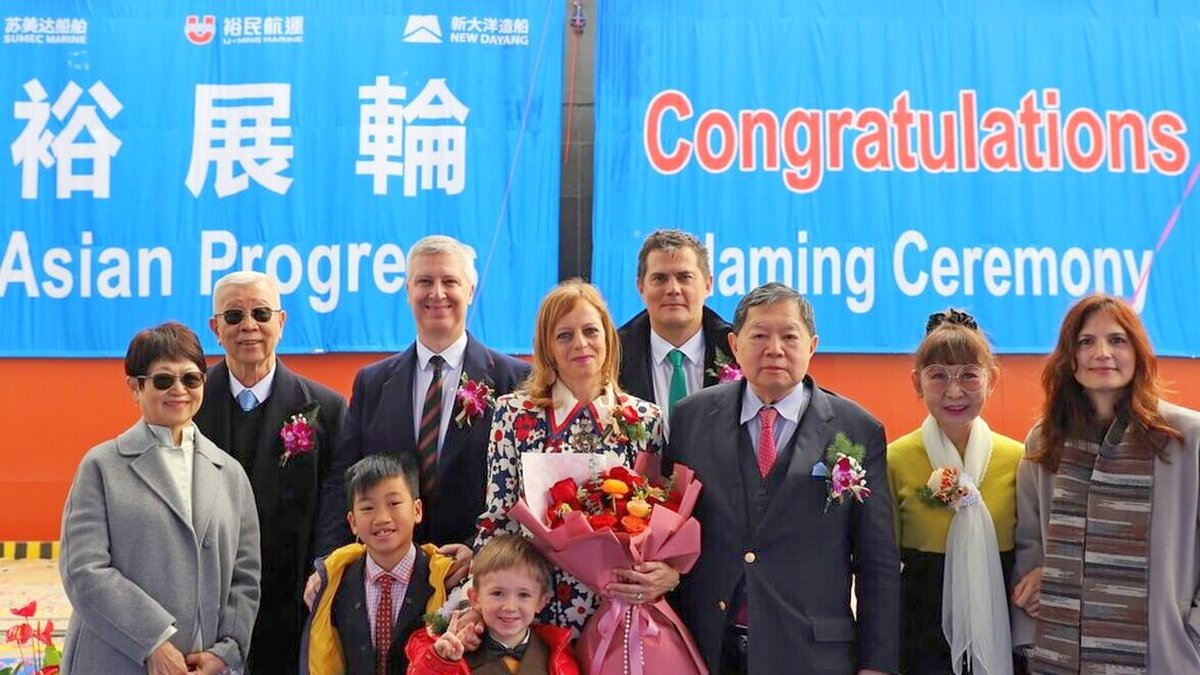U-Ming Rising to Global Changes, Shaping a Greener Future
U-Ming Marine Transport Corporation (2606) held its 2025 Annual Shareholders’ Meeting today in Taipei, where shareholders approved the 2024 financial statements, the proposed cash dividend, and the re-election of the 20th Board of Directors. Vice Chairman Douglas Jefferson Hsu emphasized the company’s continued focus on the net-zero transition and global strategy, while enhancing operational resilience and capital efficiency to deliver long-term, sustainable value for its shareholders.

Steady Operations and Strong Shareholder Returns
In 2024, U-Ming recorded consolidated revenues of NT$16.34 billion and net profit after tax of NT$4.68 billion, representing earnings per share (EPS) of NT$5.54. The meeting resolved to distribute a cash dividend of NT$3.20 per share, continuing the company’s high-payout policy as part of its commitment to rewarding shareholders underpinned by a solid financial foundation. As of today, the company’s accumulated retained earnings and legal surplus reserves total NT$20.02 billion, equivalent to NT$23.69 of distributable earnings per share, providing a strong base for stable future dividends.
Demonstrating Resilience Amid Global Uncertainty
Despite ongoing global geopolitical and economic volatility, U-Ming continues to demonstrate exceptional resilience and adaptability. According to the latest International Monetary Fund (IMF)’s forecast, global GDP growth for 2025 has been revised downward from 3.3% to 2.8%. Similarly, Clarksons reports a -0.4% decline in tonne-mile growth for global seaborne trade, reflecting weaker dry bulk demand and the impact of decarbonization trends on coal transportation.
Nevertheless, steel demand remains robust. The World Steel Association forecasts a 1.2% increase in global steel demand in 2025, driven primarily by infrastructure development and urbanization in emerging markets. The Simandou iron ore project in Guinea will commence production this year, with an expected annual capacity of 120 million tonnes by 2027. Mining major Vale also plans to increase its annual iron ore output from 320 million tonnes to over 360 million tonnes by 2030, supporting sustained demand for Capesize vessels.
On the ship supply side, vessel additions remain constrained. The newbuilding orderbook and fleet growth rate stand at only 10% and 3%, respectively – a historic low. With more than 25% of the global fleet aged over 15 years and facing decarbonization regulations, vessel renewal is accelerating. Since 2016, average global sailing speeds have declined by approximately 8%, effectively curbing fleet capacity growth. Overall, the supply-demand balance is gradually improving, supporting a cautiously optimistic outlook.
While the BDI and charter rates for major vessel types declined significantly in Q1 2025, Clarksons projects a marginal 0.1% growth in dry bulk demand for the full year. U-Ming has maintained high fleet utilization and stable profitability through efficient operations and a flexible mix of spot and long-term charters. The company continues to expand into high-growth cargo segments such as bauxite and fertilizers, enhancing its competitive positioning.
In response to short-term uncertainties including US-China trade restrictions, proposed US port fees, the Red Sea crisis, and extended energy trade routes, U-Ming has adopted a prudent strategy. This includes locking in fuel costs through long-term contracts and integrating carbon strategies into operational planning to manage oil price volatility and environmental compliance risks, enabling the company to navigate global disruptions with resilience.
Dual Transformation: Green and Digital
U-Ming is advancing both its low-carbon shipping and smart transformation agendas. As of 2024, the company has taken delivery of three Ultramax bulk carriers and one modern next-generation cement carrier, all exceeding IMO Phase 3 energy efficiency standards. An additional 11 newbuilds have been ordered (6 Ultramax, 4 Capesize, and 1 LNG carrier), with deliveries beginning in 2026.
By Q1 2025, 94% of U-Ming’s fleet will be eco-efficient vessels, with an average fleet age of just 6.8 years - significantly younger than the industry average of 12.6 years.
To further strengthen intelligent fleet management, U-Ming became the first Taiwanese owner to equip a Very Large Ore Carrier (VLOC) with rotor sails for wind-assisted propulsion and carbon reduction. Beyond low-carbon shipping, the company is expanding into clean energy transport. In partnership with Kawasaki Kisen Kaisha (“K” Line), U-Ming is developing LNG shipping capabilities. Through its subsidiary U-Ming Marine Offshore Company Limited, the company has also expanded from crew transfer vessels (CTV) into service operation vessels (SOV), further deepening its involvement in the offshore wind sector.
Advancing ESG Leadership and Industry Sustainability
U-Ming is committed to sustainable development and was once again included in both the FTSE4Good Emerging Markets Index and the Taiwan Sustainability Index in 2024. The company also received multiple accolades at the Taiwan Corporate Sustainability Awards (TCSA), including recognition as a “Top 100 Sustainable Enterprise” and recipient of the “Platinum Award for Sustainability Reporting”.
Additionally, the Ministry of Transportation and Communications awarded U-Ming for “Outstanding Fleet Expansion,” “Excellence in Green Shipping,” and “Excellence in Maritime Training.” The company also claimed the top honour in the inaugural ESG Transportation Sustainability Awards. U-Ming was further recognized by HR Asia with several awards, including “Best Companies to Work for in Asia” and the “Workplace Sustainability Award,” highlighting its commitment to employee care and a diverse, inclusive corporate culture.
In September 2024, U-Ming published the shipping industry’s first Task Force on Climate-related Financial Disclosures (TCFD) report in Taiwan, enhancing investor understanding of climate risks through transparent reporting and building a stronger sustainability governance framework.
Diversified Fleet and Global Presence
U-Ming operates a diversified fleet of nine vessel types, including Capesize, Panamax, Ultramax, Post-Panamax, specialized cement carriers, VLCCs, VLOCs, CTVs, and LNG carriers. The fleet now totals 82 vessels with nearly 10 million DWT in capacity. The company maintains its operational hubs in Singapore, Hong Kong, and Xiamen, achieving a truly global footprint.
Vice Chairman Douglas Jefferson Hsu concluded:
“With a focus on net-zero emissions, smart operations and steady growth, U-Ming is committed to enhancing capital efficiency and corporate sustainability, transforming itself into the next-generation global maritime leader.”
Business and Company
News Type
Share
Download
Source
U-Ming




